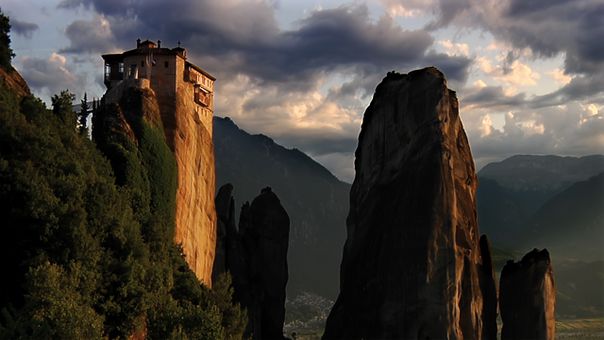Love and Monoliths
The young Greek director Spiros Stathoulopoulos is in Competition at the Berlinale with his second feature film, punctuated by forbidden attractions, opposing peaks and a peculiar style of animation.

Spiros Stathoulopoulos's METÉORA
Berlinale Competition entry METÉORA, by Spiros Stathoulopoulos, is a distilled forbidden-love story. It highlights the fundamentals – the longing, the inner turmoil, the final passionate outburst – and stretches them out across the length of a feature film, erasing nearly all extraneous details. The young lovers in this case are a nun and a monk, who live in separate monasteries atop immense and humbling sandstone monoliths. Their days and nights are spent in this fantastical, almost extraterrestrial realm. Fog coils between the monoliths, the monasteries towering over the rest of the world, like looking posts from which to observe God's creation.
There are glimpses of a society outside the context of the monasteries. A farmer speaks ecstatically of his plants. A butcher kills and then prepares a goat for cooking. But these are cracks in the otherwise strong shell of isolation that envelops the protagonists. Their love blooms when they cross each other’s paths in the valley between the monoliths. She ascends to her monastery in a net, he walks up to his via a long flight of steps. In the seclusion of their rooms, they dream in animated sequences reminiscent of pre-Renaissance religious iconography, then wake up and fall into hushed prayer in the hopes of burying their dark desires in the depths of their subconscious. But love wins.
Stathoulopoulos sets his story in a timeless landscape of such arresting magnitude that it feels like a parallel universe of ideal forms, as imagined in antiquity since Plato. Nun and monk become man and woman seeking each other out in the cloudy dreamscape of life. Their relationship has none of the complexities faced by real couples, and, although the restrictions of their faith constitute something like a social pressure, both are basically lonely figures wandering on an astral plane.
METÉORA lacks a certain boldness. Its pared-down narrative and basic characterizations reach for mythic resonance, while its sometimes striking compositions settle into a predictable pattern of wide landscape shots and artful still lifes. The film can often feel like a banal reworking of contemplative-cinema clichés. But its setting – the sheer topographical drama on display – saves it from being derivative.
On their geological perch, the monasteries radiate an insidious peacefulness, creating a cage of silence from which the lovers yearn to escape. Their flight is paralleled by the soundtrack, which often rises from its wordless stupor in dramatic crescendoes of choral music. The burdens and responsibilities that fall on the protagonists are invisible. They are not enforced by the institutional power of the church but by a religious context that argues only for the perpetuation of tradition. The lovers choose freedom, walking towards uncertainty, two dots on the barren plains.


301 Moved Permanently